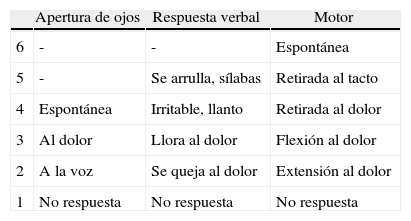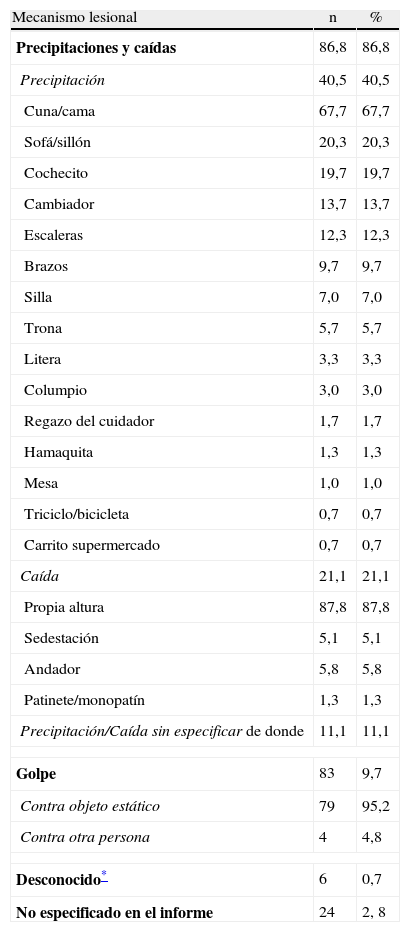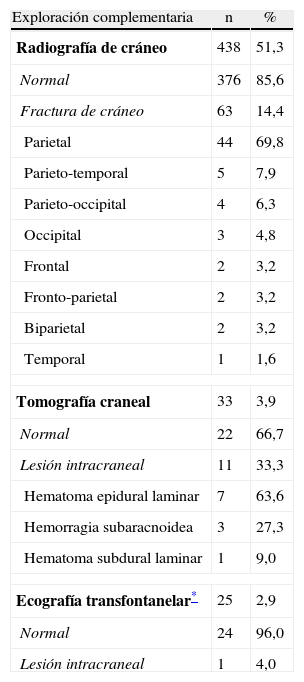La mayoría de publicaciones actuales sobre el manejo del traumatismo craneoencefálico (TCE) leve ya no tienen en cuenta la presencia de una fractura craneal para determinar el riesgo del lesión intracraneal (LIC). Sin embargo, en nuestro medio sigue siendo habitual la realización de radiografías de cráneo en los niños pequeños para descartar su presencia.
ObjetivoDeterminar la prevalencia de LIC clínicamente importante (LICCI) en los niños menores de 2 años con TCE leve atendidos en urgencias.
Pacientes y métodosRevisión retrospectiva de los informes de urgencias de los niños menores de 2 años atendidos por TCE leve (Glasgow ≥14 puntos) durante un año. Se define LICCI aquella LIC que tiene como consecuencia la muerte, una intervención neuroquirúrgica, ventilación mecánica o soporte inotrópico.
ResultadosSe incluyen 854 niños, con una mediana de edad de 11,0 meses (P25-75: 7,5-17,0 meses). Cuatrocientos cincuenta y siete (53,5%) eran varones. En 741 casos (86,8%) el mecanismo del TCE fue una caída. En 438 (51,3%) se realizó una radiografía craneal. En 11 casos (1,3%) se diagnosticó una LIC, ninguna clínicamente importante (prevalencia de LICCI en niños menores de 2 años con TCE leve: 0%; IC 95% 0-0,4%).
ConclusionesLos niños menores de 2 años con TCE leve tienen un riesgo muy bajo de LICCI. La observación clínica puede considerarse como una alternativa válida a la realización de radiografías de cráneo.
Current guidelines on the management of mild head trauma (traumatic brain injury/TBI) do not include the presence of a skull fracture in determining the risk of intracranial injury. However, in our setting cranial radiography is still performed frequently to rule out the presence of skull fracture.
ObjectiveTo estimate the prevalence of clinically-important traumatic brain injuries (ciTBI) in children younger than two years of age with mild TBI.
Patients and methodsDescriptive observational study. All children attended in emergency department with mild TBI (Glasgow ≥14 points) for a year were included. We defined ciTBI as intracranial injuries that caused death or required neurosurgery, intubation for more than 24hours, inotropic drugs or mechanical ventilation.
ResultsThe study included 854 children, of which 457 (53.5%) were male. The median patient age was 11.0 months (P25-75: 7.5-17.0 months). In 741 cases (86.8%) the mechanism of TBI was a fall. In 438 cases (51.3%) skull radiography was performed. Eleven children (1.3%) had intracranial injury, but none met the criteria for ciTBI (estimated prevalence of ciTBI was 0%; CI 95%: 0%-0.4%).
ConclusionChildren younger than two years of age with mild TBI have low prevalence of ciTBI. Consequently, it is possible to monitor children younger than two years with a TBI without performing skull radiography.
Article

If it is the first time you have accessed you can obtain your credentials by contacting Elsevier Spain in suscripciones@elsevier.com or by calling our Customer Service at902 88 87 40 if you are calling from Spain or at +34 932 418 800 (from 9 to 18h., GMT + 1) if you are calling outside of Spain.
If you already have your login data, please click here .
If you have forgotten your password you can you can recover it by clicking here and selecting the option ¿I have forgotten my password¿.










